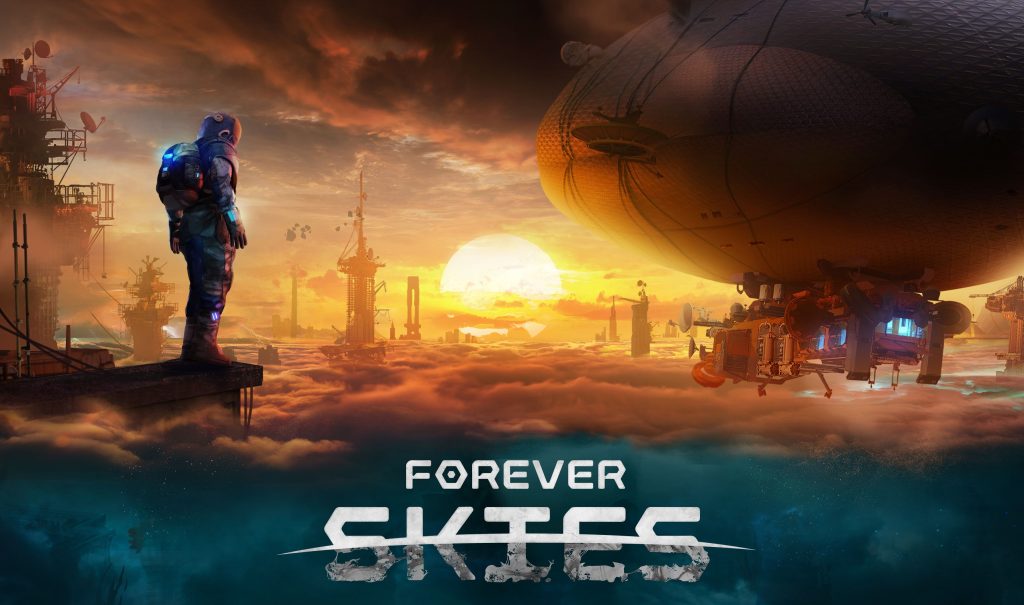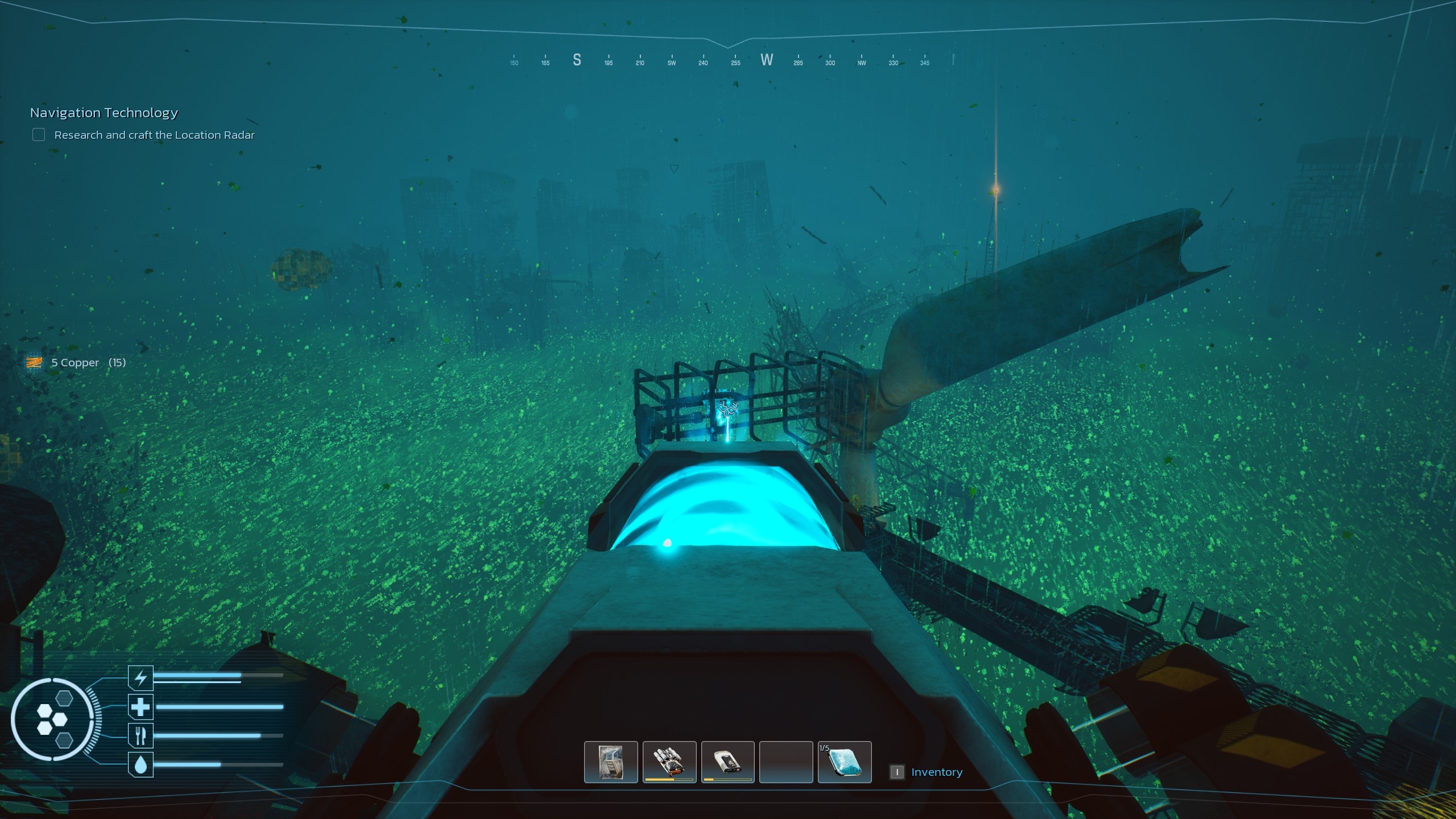
Forever Skies
Introductory note: This review is based on October 2023’s “Viral Evolution” update, which adds a virus/immunity system to the game. It does not reflect the state of previous or subsequent updates. As the game is in Early Access, major changes are expected.
In Forever Skies, the skies of a (partially procedurally generated) ravaged Earth are yours for the taking. It’s a game along the lines of Subnautica, Raft or Green Hell – titles the developers at Far From Home openly cite as inspiration. Expect exploration (including story elements), survival elements, resource gathering and crafting. Instead of building underwater bases, a floating home, or jungle huts, you commandeer and expand your very own airship, balloon and all. Flying to spire-like platforms and exploring (and looting) those makes up the majority of this game. The looting experience is reminiscent of picking up loose loot in Fallout titles, except that the derelict platforms here require careful movement, as any steep falls without solid ground below most definitely result in your death. Below a certain altitude, you and your ship take damage from dust storms, and if you descend low enough, you die, so don’t expect trips to the planet’s surface.

The afore-mentioned October update added another level of complexity to the game’s survival elements. Energy, health, nutrition and hydration bars need to be maintained at a high level to keep your character’s immunity score up. Outside the tutorial area, you can contract viruses and then have to cure them. How fast these meters drain depends on the chosen difficulty setting, and that furthermore affects the effects of death. On easy, there is no penalty for death, whereas on normal and hard, you lose a percentage of your resources, and there’s a permadeath mode too. Due to the risk of falling from a structure or your ship after a careless misstep, I would only recommend it to true masochists. After a recent update, the difficulty setting can be changed at any time. While there is some hostile flora and fauna to be found, the developers have said they won’t add human enemies to fight, and thus there obviously won’t be ship-to-ship combat. Enemies are meant more as progression checks that you can get past once you have the right items. They are fairly static and not meant to challenge your FPS skills.
While keeping your character alive and your airship intact requires a constant flow of resources, the most basic ones are provided very generously. Floating debris is enough to keep your insect catcher and water condenser going, and cooking what you obtain via the insect catcher is the primary way of obtaining food. As these are effectively infinite resources, and you have an effectively limitless number of locations to land on and loot, Forever Skies is not a game about making do with the last resources left on a destroyed world. At the same time, it is not about building a self-sufficient base that produces advanced resources to keep growing, either. While getting the bare necessities in a pinch is no problem, any time a specific rare part is needed to craft something, that tends to mean a trip to a location it’ll spawn in. This goes from batteries for keeping your hand-held tools charged to different liquids used in crafting recipes. The December 2023 update will add gardening, but until then, to deal with viruses on hard difficulty you might need a trip to a greenhouse location, and since collected plants spoil over time, you cannot stockpile them either. Obtaining new technologies also requires you to scan devices or collect datapads in specific location types, rather than points for the unlock tree as seen in sandbox crafting games.

Your airship is constructed from square rooms that snap together, which is once more reminiscent of Subnautica. Stations that produce or process are placed inside your ship, while placing catwalk tiles on the outside is required for stations that interact with the environment, like water collectors, insect catchers, and the all-important extractor, with which you suck up resources from certain big stationary objects and floating debris alike. Adding more or better engines lets you go faster, additional turbines enable you to reach higher altitudes (and thus higher-tier structures), and increasing the size of the balloon on top (or even adding additional balloons on a truly big airship) boosts the lift capacity so that you can build a bigger boat. The chosen shape of course strongly influences how many obstacles one usually collides with and how hard it is to park at a structure.
I called the game partially procedurally generated because despite there being a few biomes recognizable at a distance, the platforms you spend most of your time on come from a relatively small pool of prefabs. Some of these also come with additional variations, but not in a way that makes them feel distinct – compare it to how every time you start a mission in Icarus or Payday 2, there are some subtle changes to the level. Time will tell if the developers can spruce up their procedural generation to a degree that could rival the exploration variety of, say, the static world in Subnautica. I would estimate the current content in the 10–15 hours range, or 25 hours if you want to put time into building out the airship or hunting down every last craftable blueprint.

In some ways, the game is quite polished already. Whenever anything happens, your suit/ship voice lets you know (think Subnautica), and stations that want attention will emit some appropriate noise until they get it. Thanks to that, I was never caught off guard by my character starving or my ship taking damage. The tutorial does a fine job of guiding you, with an objectives checklist stretching deep into the game, so you are never lost with no idea what to do. On the other hand, some other obvious quality of life improvements are absent: for example, when crafting items there is no output number shown, so you might conclude that a specific machinery part is very expensive to obtain, while you actually get five of them for their displayed cost. Since all crafting happens on a single airship, there is no good reason why the game does not let you craft from containers, or even have access to a global inventory while on the ship. Keeping track of which box holds your circuit boards ultimately is as boring as remembering where you placed those iron ingots is in other titles. (Of course many players won’t want a shared inventory for future co-op play, so if implemented it would have to be an optional/controllable feature.)
Forever Skies is pretty to look at, but this comes at a high hardware cost – weak laptops need not apply. Achievements aren’t available yet, though they were cited as a feature to expect sooner rather than later. Finally, compared to established games in the genre with more years of development, there is a limit to the tech tree depths, there are not all that many available ship parts, and the structures you explore get repetitive after a while. At the time of writing, there isn’t much third-party content either: almost all of the available mods are cheats like more inventory slots, bigger stack sizes, or no food decay. If you are happy to dip your toes in during Early Access, rest assured that save games are intended to remain compatible through full release.

As someone who enjoyed walking off into a random direction and seeing what awaits me in the likes of Minecraft and Valheim, I could not help thinking how much more I would enjoy this game with a friend or two. One player piloting the ship, another extracting floating debris or stationary resources, another cooking or crafting… The developers have put four-player support on the top of their list, and being able to play with friends would surely entice me to put many more hours in – if there also is something meaningful to work towards, that is.
I found the exploration aspect of Forever Skies quite satisfactory, but then again, the previous paragraph should make it clear that I’m all too happy to misappropriate the game as a sandbox experience. Players specifically looking for a well-concluded narrative throughout their crafting adventure should wait until there is more meat on this dust moth, as presently only the precursors of storytelling are in place.
Disclaimer: This game is on Steam in Early Access, which means it is still under development and may change significantly over time. The review was conducted based on the game’s current state, and it is possible that the review may not reflect the current state of the game after updates.